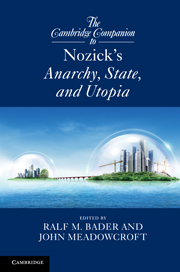11 - E pluribus plurum, or, How to fail to get to utopia in spite of really trying
from Part IV - Utopia
Published online by Cambridge University Press: 28 September 2011
Summary
INTRODUCTION
“The framework for utopia,” Robert Nozick tells us at the beginning of the final section of Part III of Anarchy, State, and Utopia (ASU), “is equivalent to the minimal state” (p. 333). The rich and complex body of argumentation of Parts I and II had produced the conclusion that the minimal, and no more than a minimal, state was legitimate or morally justified. What Part III reveals is that the minimal state “is the one that best realizes the utopian aspirations of untold dreamers and visionaries” (p. 333). Although this happy convergence is surely no accident, neither, Nozick insists, is it contrived, for it is the conclusion reached by two independent lines of argument. If there is a framework for utopia - or, as I shall from now simply say, utopia - it is the minimal state.
The obvious question to ask, then, is whether Nozick is right that the minimal state gives us utopia – understanding utopia in the way that he would have us do. The thesis of this chapter is that Nozick does not succeed. What Part iii offers is neither a plausible account of a utopian community nor the inspiring conception of a state that Nozick promises. The root of the problem lies in Nozick’s initial rejection of anarchy, for the idea of utopia he wants to defend is one that is achievable outside the state but not within it.
- Type
- Chapter
- Information
- The Cambridge Companion to Nozick's Anarchy, State, and Utopia , pp. 289 - 302Publisher: Cambridge University PressPrint publication year: 2011
- 2
- Cited by

